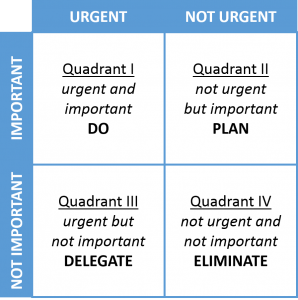Forward progress happens when we “put first things first”. Deciding what’s important and moving it to the top of your to-do list is the foundation of every productive day.
 President Dwight D. Eisenhower gave credit to an “unknown university president” when he uttered his now famous commencement speech quote:
President Dwight D. Eisenhower gave credit to an “unknown university president” when he uttered his now famous commencement speech quote:
“I have two kinds of problems, the urgent and the important. The urgent are not important, and the important are never urgent.”
The former World War II General is the namesake for the Eisenhower Matrix, familiar to most of us as a fundamental decision making tool to help us put first things first.
Quadrant I. Urgent and important (Do these things first)
True crises and important projects on deadline fall into this square. Things that keep food on the table, keep your kids on track and your significant other happy often end up on to-do lists. Deconstructing the President’s quote, you quickly get the sense that an important and urgent thought process is deciding what truly is important and urgent.
Be careful not to let others decide what is important and urgent. Definitely input many opinions. But only you get to choose what gets priority in your life. When I speak on this topic I always warn that “not deciding is also a decision”.
Quadrant II. Not urgent but important (Plan how and when you will get these things done)
This is the quadrant where self development and the nurturing of important relationships live. It’s easy to forget to do these things. We begin our days with plans and then the hand grenades start flying at us. Time passes quickly, and we have to be careful to dedicate both thought and action to planting and feeding the seeds of our own growth.
Many of us keep pictures of our families, images of experiences we hope to have and things we want to acquire on our desks to remind us to invest now to make future goals happen. Develop your own system to help keep the important but not urgent things in the back of your mind. You’ll always find time in the busiest days to put some effort toward activities with a longer term pay off. Like the “dollar cost averaging” investment strategy, it’s a great way to generate massive returns in the future.
Quadrant III. Urgent but not important (Delegate, find someone or something that can do these things for you)
Don’t get bogged down trying to do things that are not your core competencies. If we want to develop them as such, move them up to Quadrant II. But in many cases, there are ways to automate and delegate distractions with deadlines.
This is why administrative assistants have great careers. And it’s the basis for many of Tim Ferriss’ “Tools of Titans” and websites like Fiverr.com. If you don’t have the skills, outsource the work.
Quadrant IV. Not urgent and not important (Minimize and or eliminate these things from your life)
I used to get kidded by my cable TV colleagues because I spent so little time in front of the set. I knew my products, but I also realized that it’s easy to fall into a binge, consuming hours of mindless “entertainment” that is tension relieving and not goal achieving.
The ability to talk cogently about popular culture and the world around us is an important skill (Quadrant I). It’s not urgent (Quadrant II), but there are tools (Quadrant III) that we can use to keep us up to date on helpful factoids that can lead to better decision making and stronger alliances.
And it’s OK to relax and binge a little on your favorite TV shows as a reward for knocking out your tasks in Quadrants I and II. Just don’t get addicted to it.
The habit of putting your tasks into the Eisenhower Matrix can supercharge your productivity and build the important habit of thinking about how you want to spend your days.
This past week I had the treasure pleasure of picking my grandson up from school and guiding him through his afternoon activities. He naturally felt the following things were important and urgent:
- Dairy Queen Ice Cream
- Playing video games on his tablet
- A snack
- Watching television
When we arrived home, I saw that he had not picked up his room before school in the morning. A quick clean up became a Quadrant I activity as we talked about what his homework assignments were.
We rewarded ourselves with a snack after the first task. Quadrant I for my grandson and Quadrant IV for me.
Then, I agreed to clean up the mess from our break while he dug into his homework. He delegated something I could do to help so he could work on his Quadrant I list.
When the homework was done, we laid out his clothing and made sure his backpack was ready to go for the next day, Quadrant II.
We were both pleasantly surprised when all the things on his “Put First Things First” list were done before dinnertime. That freed us both to spend quality time with his parents and his sister when the rest of the family came home. And yes, he also had time for his tablet and few cartoons.
As you can imagine, the smooth progression I described didn’t quite happen that smoothly. All of us have 8 year old brains hiding among our more mature gray matter. His attraction to Quadrant IV – tension relieving activity is immense and helping him keep it at bay is always Quadrant I activity for us so-called grown-ups.
We all have inner voices that try to distract us from putting first things first. With practice, we can hear them, recognize what’s driving them and effectively filter out the noise.
That helps position us to attack next week’s topic, “Thinking Win-Win”.